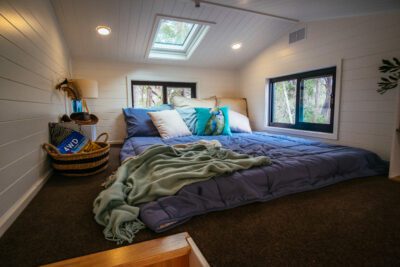Tiny Answer to a Big Problem: Tiny Houses and the Affordable Housing Crisis
Tiny houses have been in the spotlight again as one potential way to address the ongoing affordable housing crisis. Costing a fraction of the average house price to purchase, and offering significant lifetime savings through reduced energy bills, there is plenty of evidence to support the idea that tiny houses could offer a solution for many of the people who are being affected by the housing crisis.
New data from the Commons Library has put the total number of new houses needed in England at 345,000 per year. In the 2019/20 year, England’s housing stock increased by 244,000 homes, an impressive number, but still nowhere near what we need. There is an increasing year-on-year need for more homes, and there is a backlog on top of this stretching back decades.
People in need of housing find themselves in all kinds of different situations, from the most extreme cases where people are experiencing homelessness (devastatingly, a number that has increased by over 250% under the Conservative government), to the now infamous Generation Rent, comprised of adults having to live at home with their parents or house share as tenants well into their forties.
Politicians, developers, and social commentators alike agree that there is no ‘silver bullet’ to fix the complicated problem of the housing shortage, which means there is an ongoing need for a range of solutions. But, it is not just the absolute number of homes that is a problem, it is also the affordability of those homes.
In a 2017 report titled What more can be done to build the homes we need? Sir Michael Lyons argued that: “It is not just the number built but also the balance of tenures and affordability which need to be thought through for an effective housing strategy.” This stance is emphasised in research carried out by the National Housing Federation which identified a need for 340,000 homes each year to 2031 of which 145,000 “must be affordable homes”.
This is where tiny houses can really shine. In a 2017 government whitepaper called ‘fixing our broken housing market’, the following recommendations were made.
- Building the right homes in the right places.
- Building them faster.
- Widening the range of builders and construction methods.
Here is how tiny houses can contribute to meeting these important aims and spread the benefits of tiny living to as many people who want to enjoy them as possible.
- Building the right homes in the right places. Tiny homes are versatile and easy to move. They can be parked in urban or rural areas, providing the correct permissions are available. This means families that might be priced out of neighbourhoods can stay together. It also makes households more mobile to take advantage of employment opportunities.
- Building them faster. Conventional homes simply cannot compete with the speed of tiny house construction. A beautiful, affordable, well-designed tiny house can be completed in a matter of weeks.
- Widening the range of builders and construction methods. The UK’s housing market has been monopolised by a small number of big builders who maintain artificially inflated prices for new builds. Opening up the market to small, family run businesses like ours brings diversity and true competition to the market, meaning a better deal for customers.
House prices, as measured by the UK House Price Index, increased by 10.0% between May 2020 and May 2021. In the same period of time, average earnings went up 6.6 percent. This discrepancy is a big problem, especially when we think about the compounding effect of the ballooning property market and stagnating wages over the course of a lifetime. The affordability of tiny houses is one way to interrupt this harmful pattern.
Tiny houses are a tried and tested form of housing which are already providing relief and freedom to thousands of people all over the world. We are excited to be part of this movement and are looking forward to helping you be part of it too.


